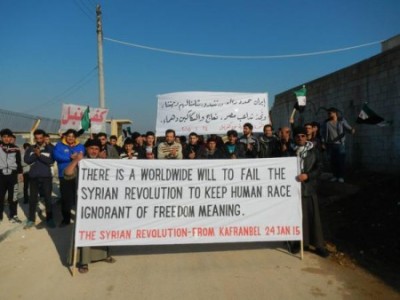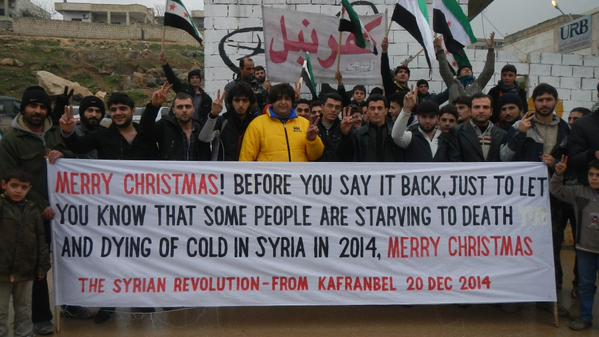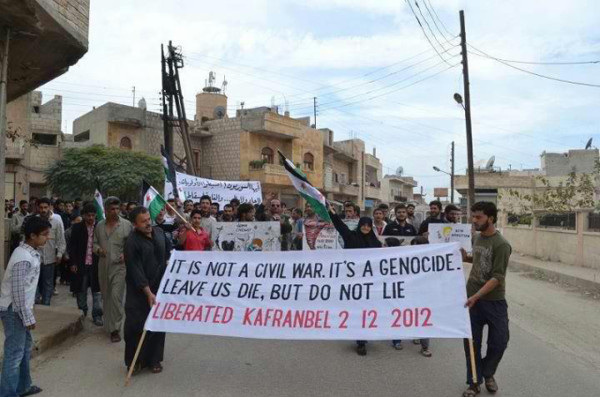Originally written for The Conversation:
Last Thursday, these were some of the developments in Syria’s four-year conflict:
*Rebels launched more than 100 rockets into Damascus, and the Assad regime fired mortars on areas of its own capital, hoping to discredit the insurgents. At least six people were killed in the attacks.
*That death toll was far exceeded by almost 50 regime airstrikes on opposition-held areas near Damascus, with at least 76 people killed. Up to 38 more were killed in Aleppo when a barrel bomb hit a bus on a roundabout.
*Rebels claim they killed 30 Hezbollah, Iranian, and Iraqi men fighting for the Assad regime when they blew up a militia headquarters west of Damascus.
*More than 20 US-led coalition airstrikes were carried out in eastern Syria against the Islamic State. Civilian casualties were reported.
See Syria Daily, Feb 5: Insurgents Begin Rocket Attacks on Regime Forces in Damascus
All this while US-led coalition air strikes were carried out in eastern Syria against the Islamic State (IS), with Jordan in particular vowing to “wipe them from the face of the Earth” after the group murdered a captured pilot.
Take a look at the world’s media coverage, though, and you might be forgiven for thinking things were rather more quiet.
Silence
If you read The New York Times, you are unlikely to learn about any of this, as the newspaper has no report from its correspondents. The same is true of the Washington Post, CNN, and Al Jazeera English. And the BBC? As the attacks and the deaths mounted on Thursday, its lead story was on the conviction of former pop star Gary Glitter on sexual assault charges.
An exception to the void was Reuters (“Syrian Air Strikes Kill 82 After Rebel Rocket Attack“). The BBC later made partial amends on its website with “Syria Conflict: Dozens Killed in Heavy Damascus Fighting“. However, both articles relied almost exclusively on the British-based Syrian Observatory for Human Rights, which often passes off rumor and chatter on social media as its news “network” inside Syria.
There are practical reasons why gathering and circulating important news from Syria is difficult. Foreign media have had to withdraw journalists because of threats to their security, elevated by the rise of the Islamic State, and local stringers have also had to flee the country. The fog of conflict and the attempts by all sides to “spin” events can make verification difficult.
However, it is still possible to provide in-depth, day-to-day coverage of the conflict, with careful analysis of the political, economic, humanitarian, and military dimensions. Even a small news organization can work with local activists, citizen journalists, and official sources — from all sides — to ensure readers are informed and ask challenging questions.
The real problem is not the impossibility of “seeing” what is happening in Syria. The downfall for most of the media is that it is so much easier to grab simple, if often misleading, labels rather than deal with the complexity of the crisis.
Last year, that label — which never quite came to pass — was “Assad is Winning“. This year, it is “Jihadist, Extremist, Jihadist”: this refers to both the Islamic State, which is fighting Syria’s rebels, and to the “Al Qa’eda-linked” Jabhat al-Nusra, which often fights alongside those rebels.
The attention to the Islamic State, given its advance in northern and eastern Syria as well as its high-profile executions of hostages, is understandable. However, the reduction of Syria’s insurgency and opposition to “Jabhat al-Nusra” is a serious distortion of the situation.
The Distortion of the Main Attraction
While effective on the battlefield, Jabhat al-Nusra provides a fraction of the fighters against the Assad regime. It is small compared to the largest insurgent factions, the Islamic Front and the Free Syrian Army. These are part of blocs with the vast majority of Syria’s rebels, such as the Sham Front and Southern Front, which go almost unnoticed in Western media.
In recent months, the Free Syrian Army, Islamic Front, Sham Front, and Southern Front have not only dented the image of regime ascendancy but have made notable advances throughout Syria. Sometimes working with Jabhat al-Nusra, they have moved into towns and villages and captured Syrian military bases. They now control most of northwest and southwest Syria, and they advanced from the south towards Damascus in January. These groups have also been battling the Islamic State throughout Syria, from Aleppo Province in the northwest to Hama and Homs Provinces in the center, to the greater Damascus area.
But if there are no “jihadists” or “extremists” for the headline, does this real news make a sound? Many analysts have effectively given up on a thorough evaluation: it is far easier and more dramatic to post the latest social-media flutter about a foreign fighter. An entire website is dedicated to “Jihadology“, and a leading news agency creates “Under the Black Flag” on the Islamic State with critiques such as “‘Watch Out For Satanic Earrings!’ IS Publishes Women’s Manifesto”. In contrast, there are almost no sites devoted to analysis of both the state of the Syrian opposition and the Assad regime, or indeed the situation for the Syrian people beyond the competing sides.
The Two Conflicts: The Dramatic and the Disappeared
The outcome is that there are two very different Syrian conflicts. The more prominent is the soap opera in which the villainous Islamic State replaces Assad and extremists replace the insurgency and opposition. This morning’s episode in most outlets is “Jordan Unleashes Wrath on Islamic State”, in response to the jihadists’ execution of a Jordanian pilot, even though the extent and location of the claimed airstrikes is unclear.
Meanwhile, the more substantial Syrian conflict — the one with another 200 deaths daily and 300,000 since 2011, with 4 million refugees, and 7 million displaced inside the country — disappears.




